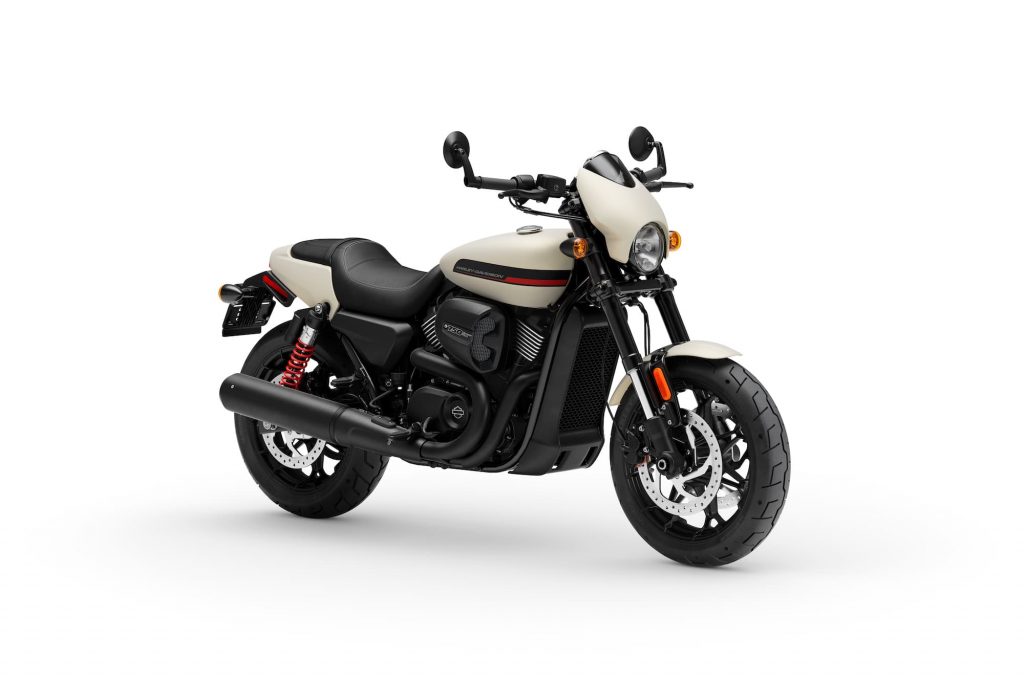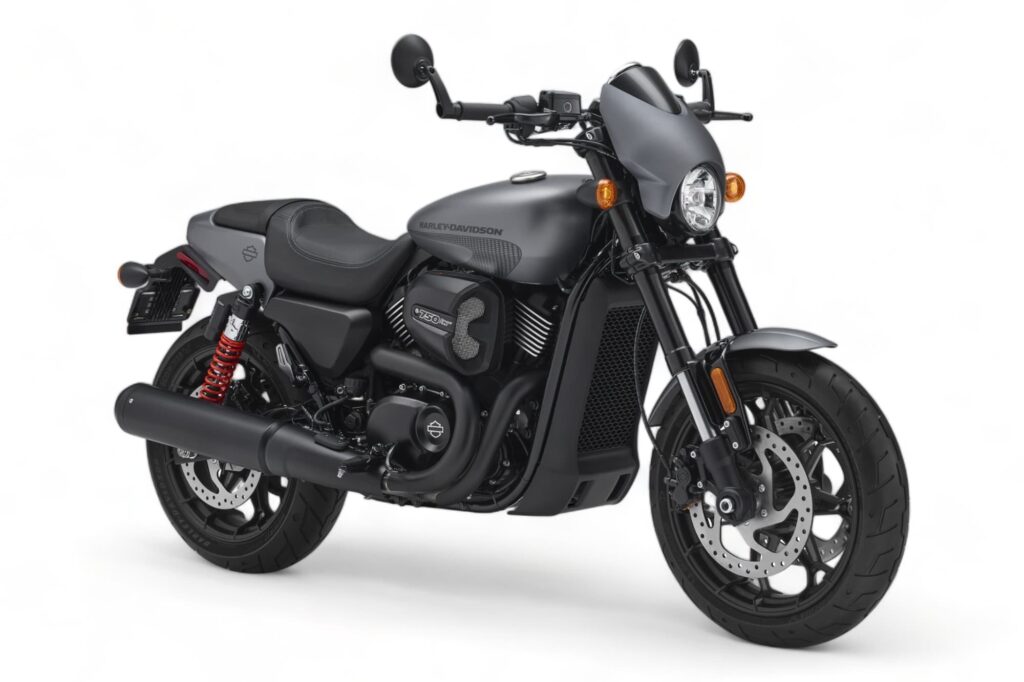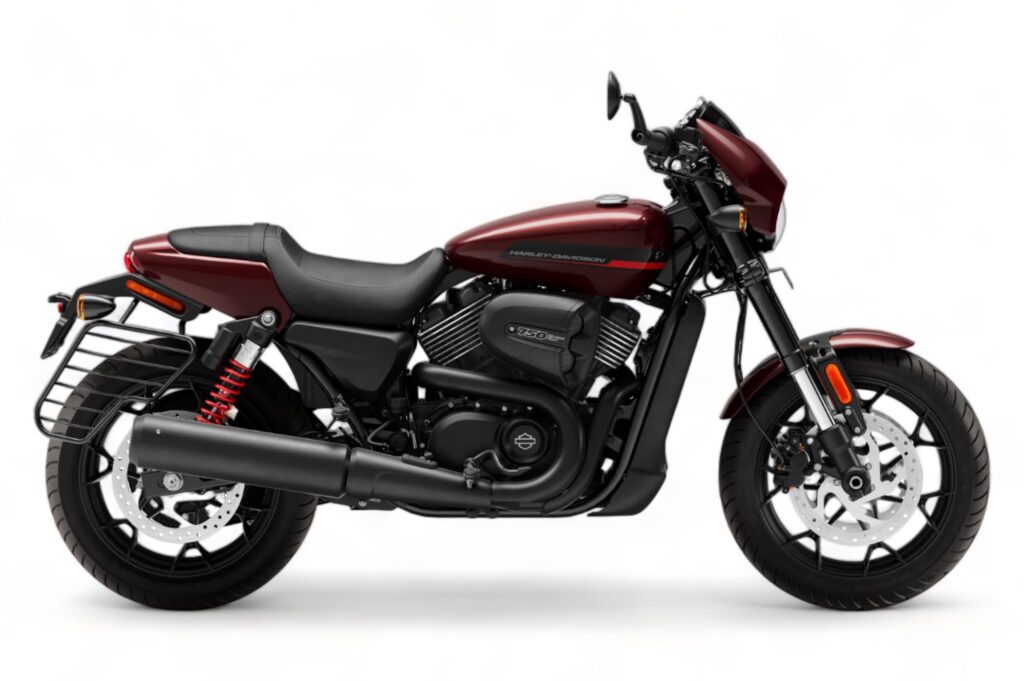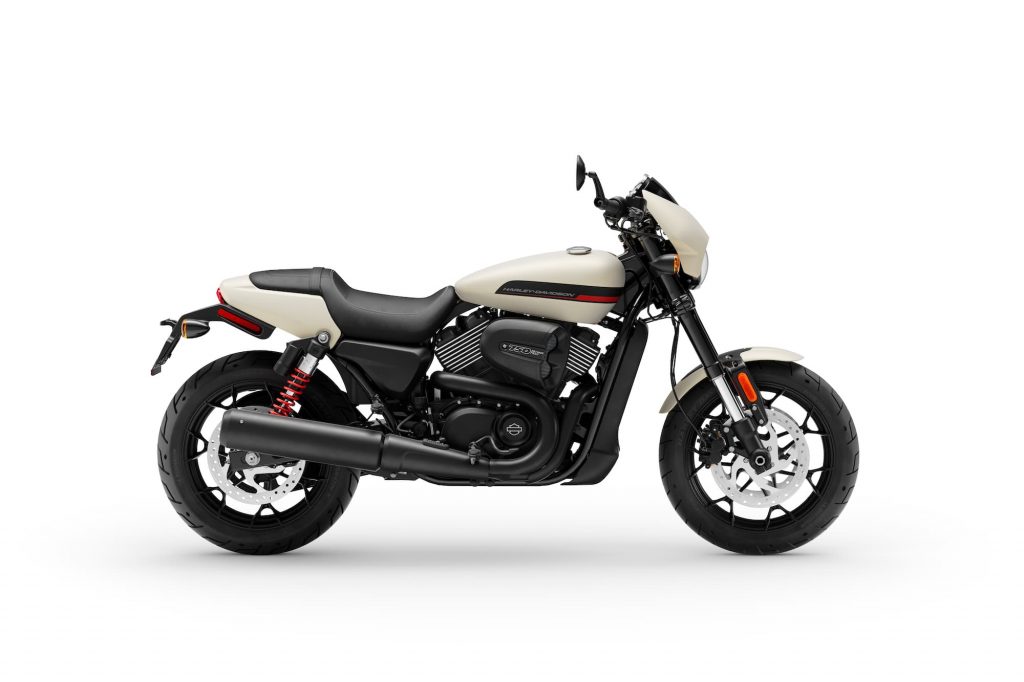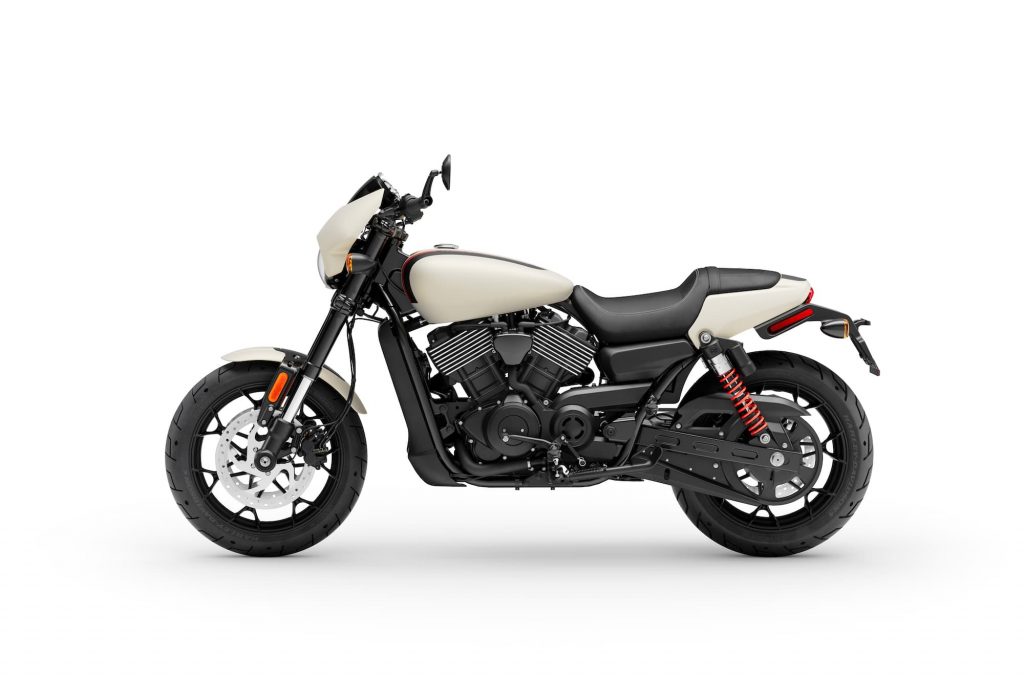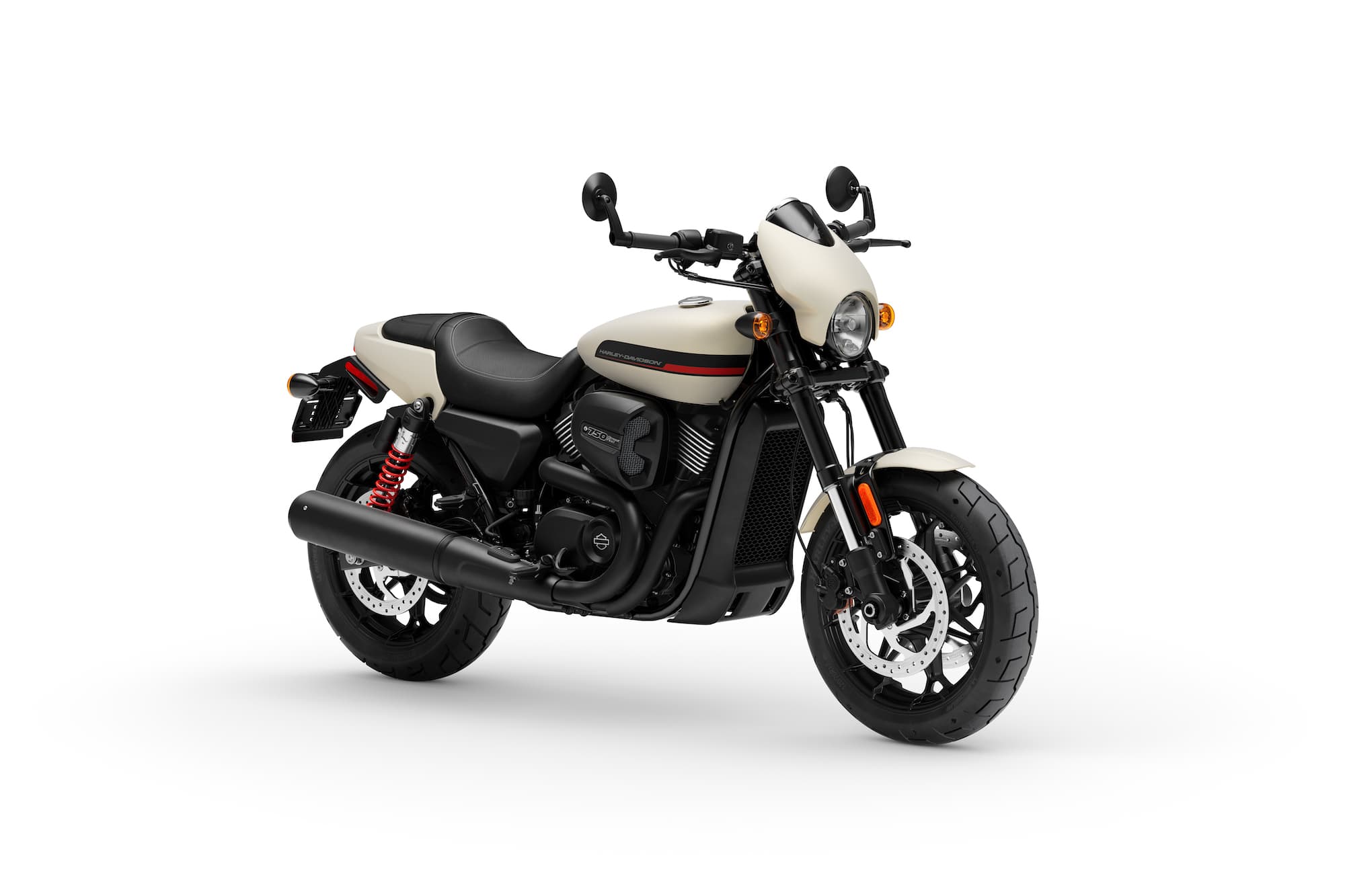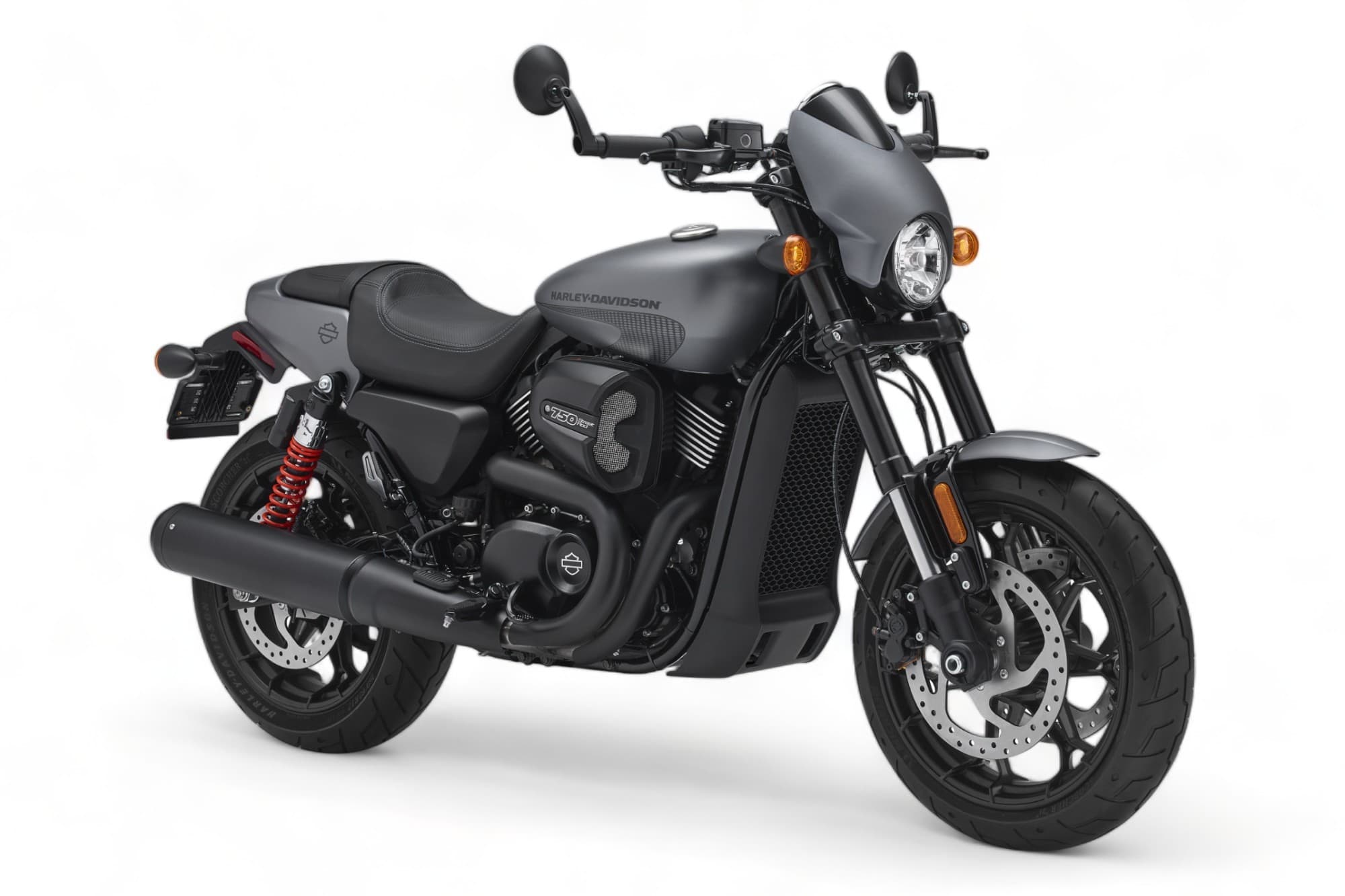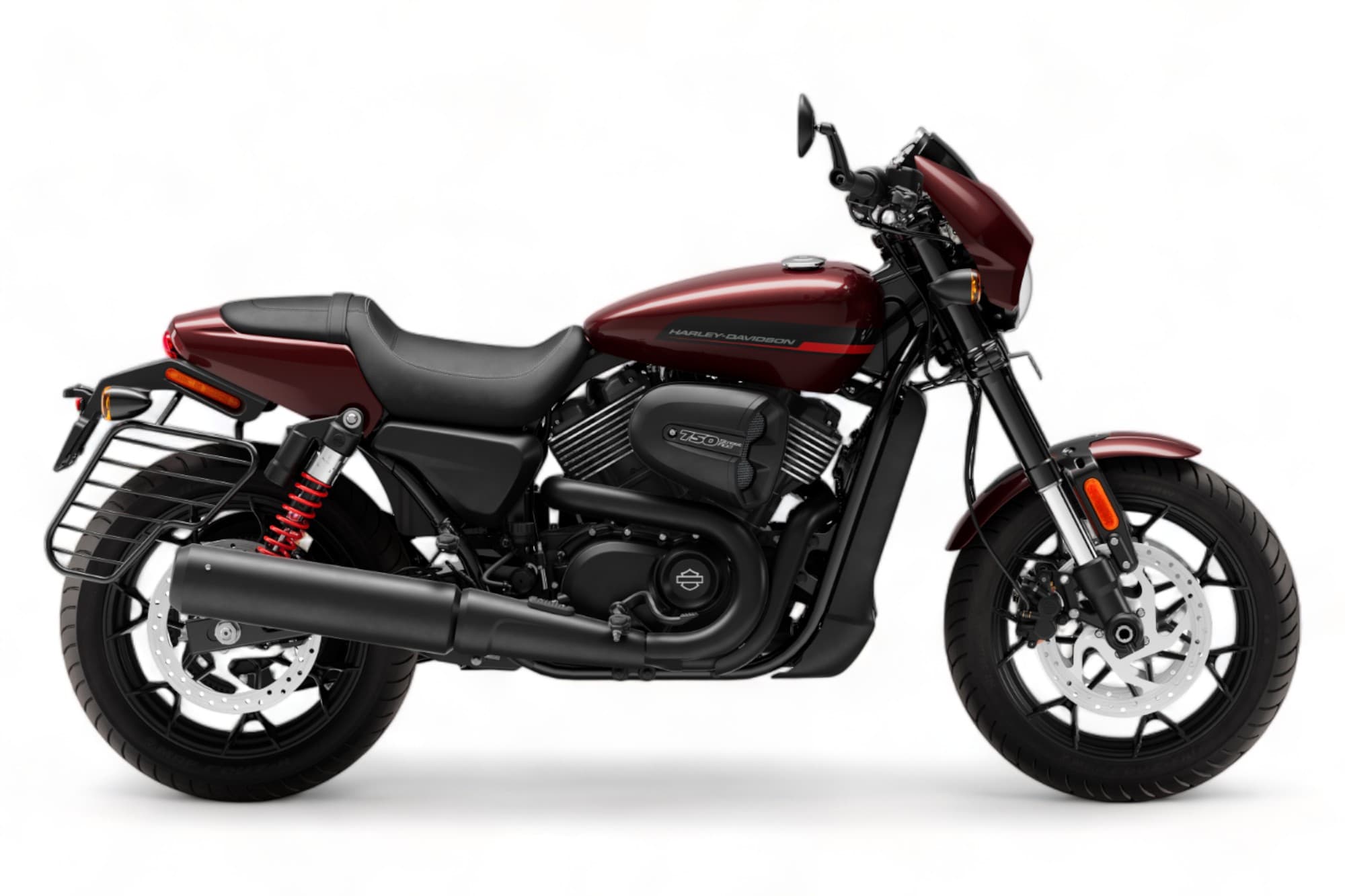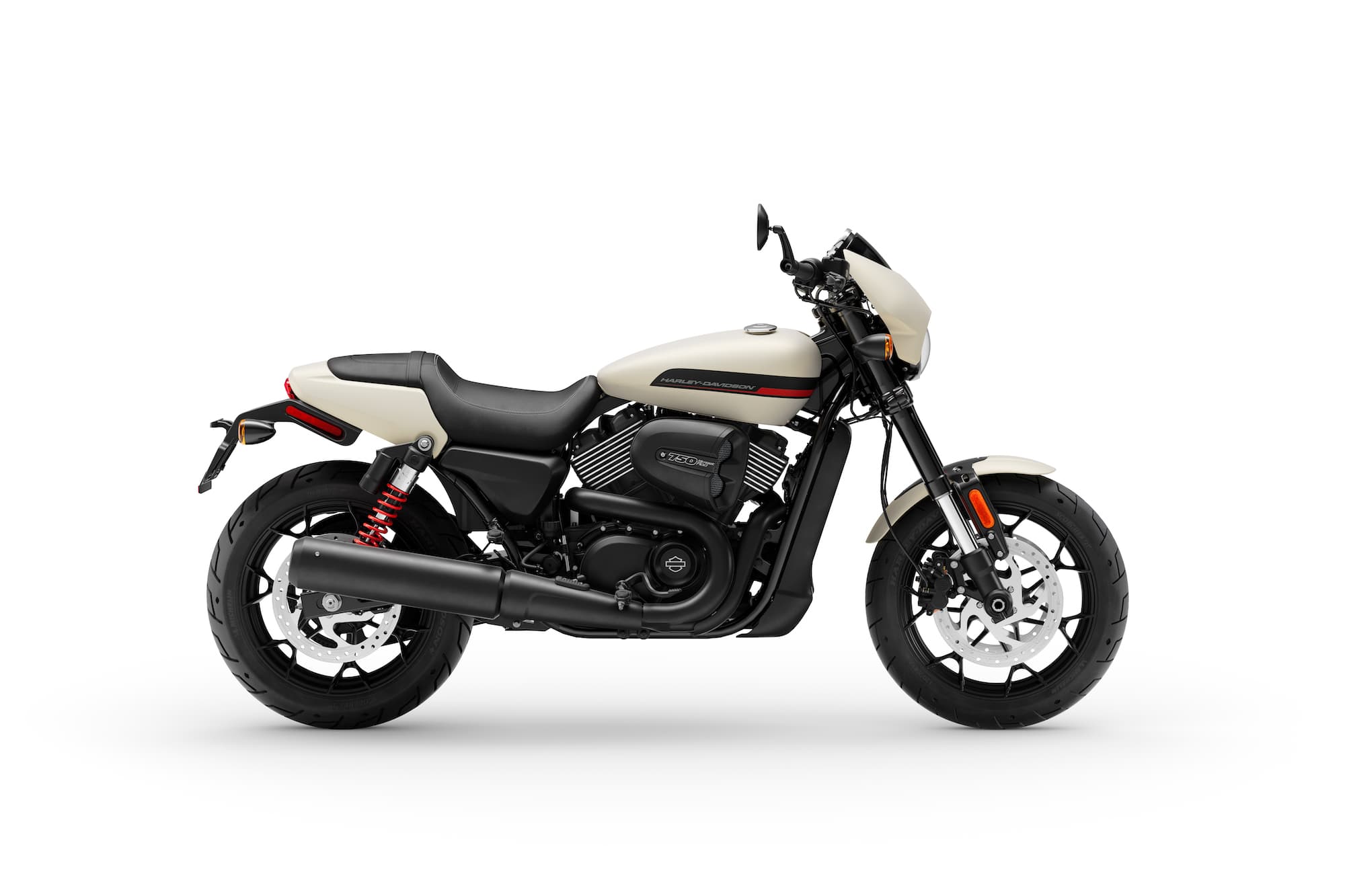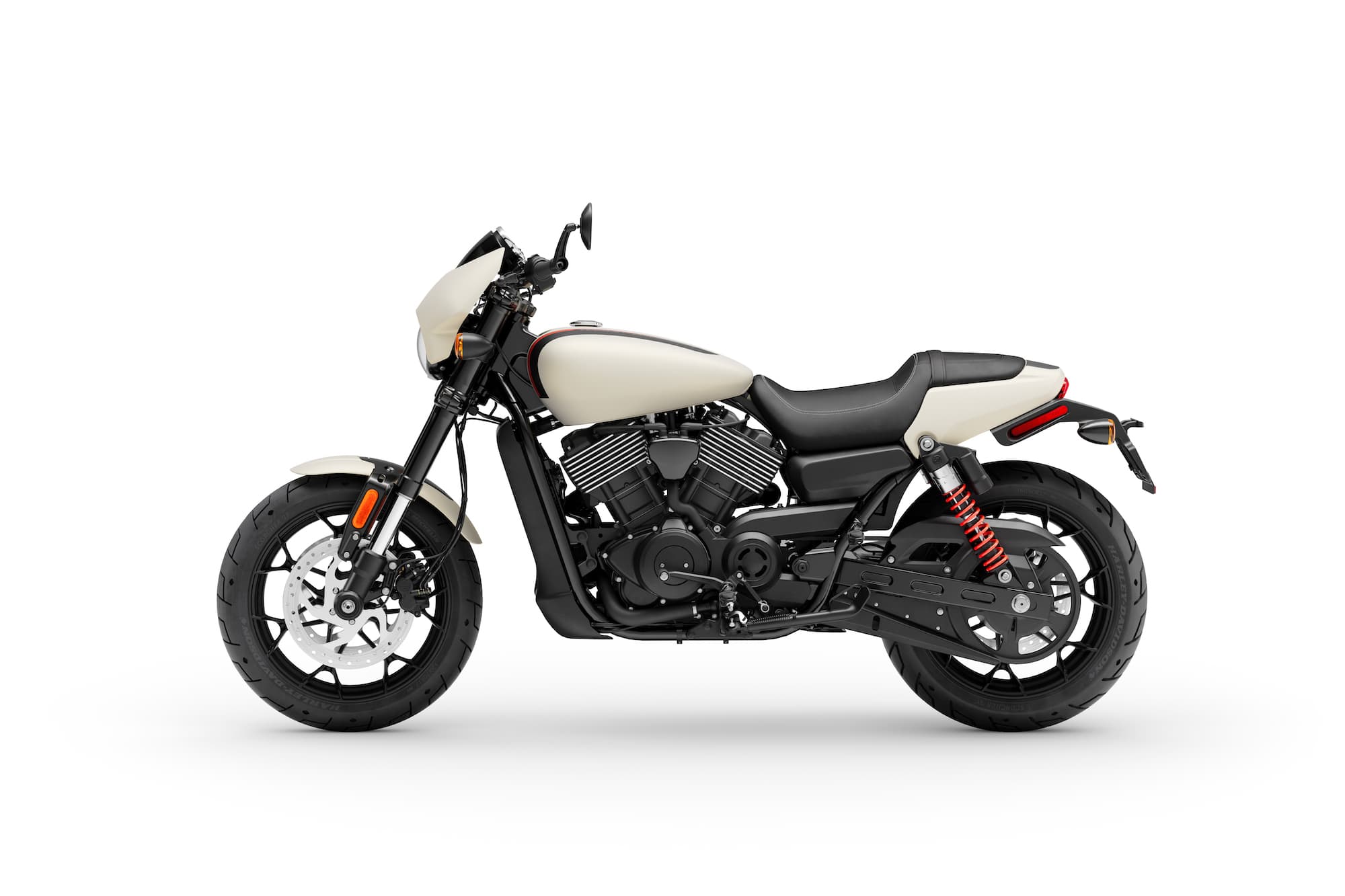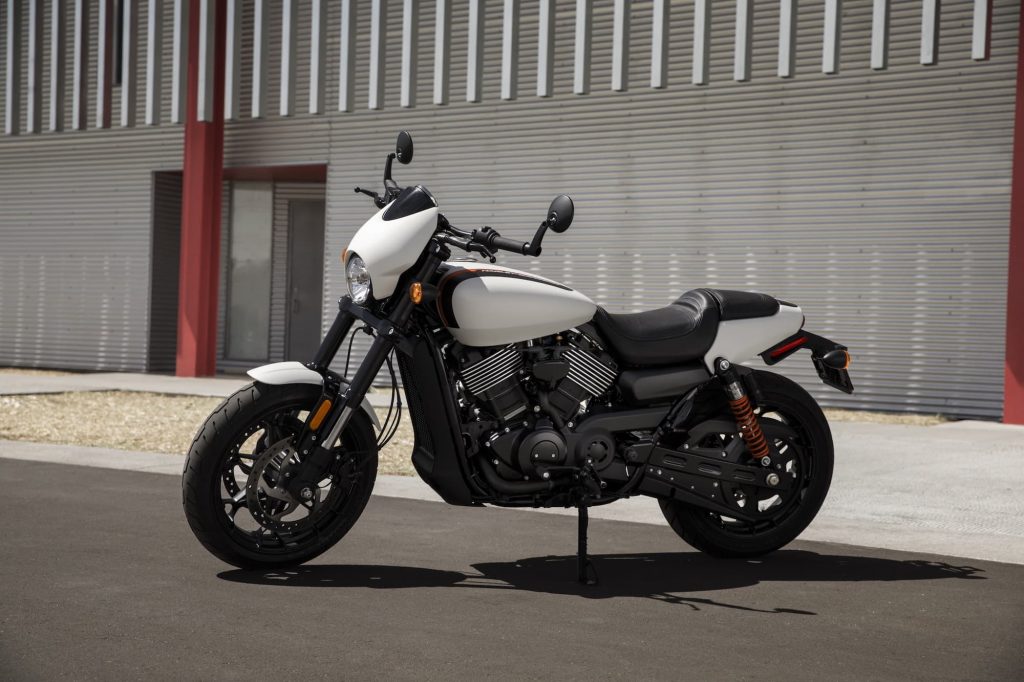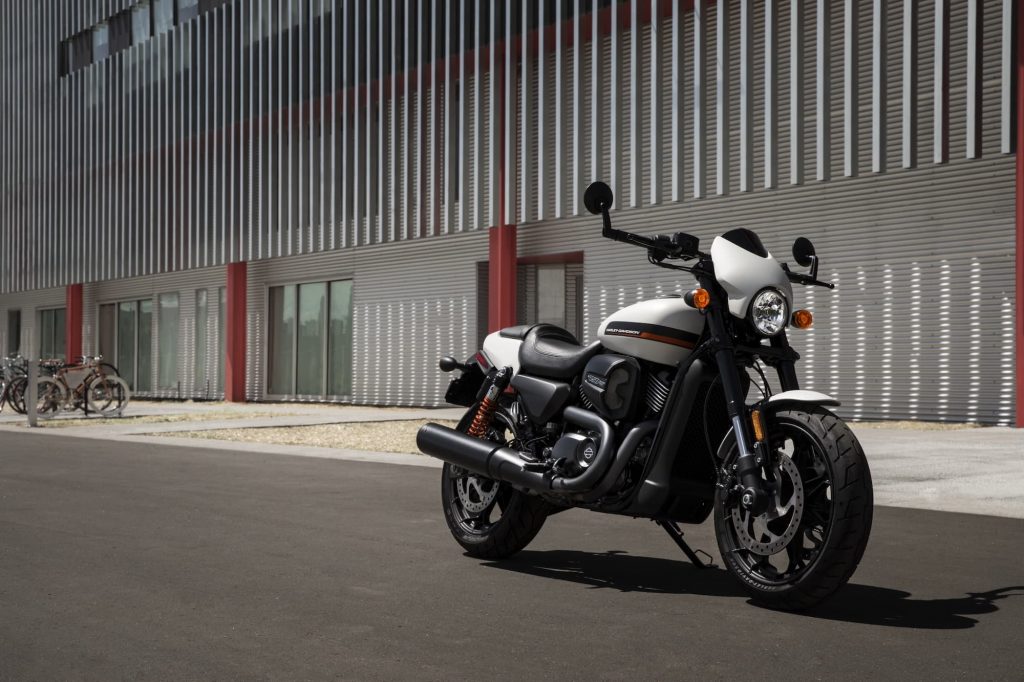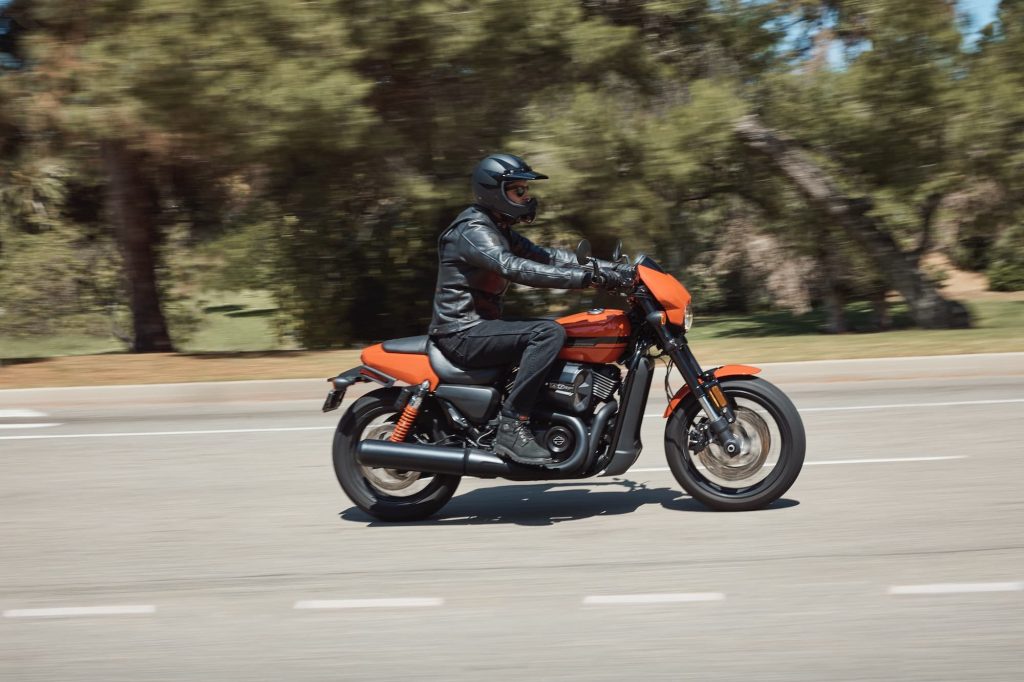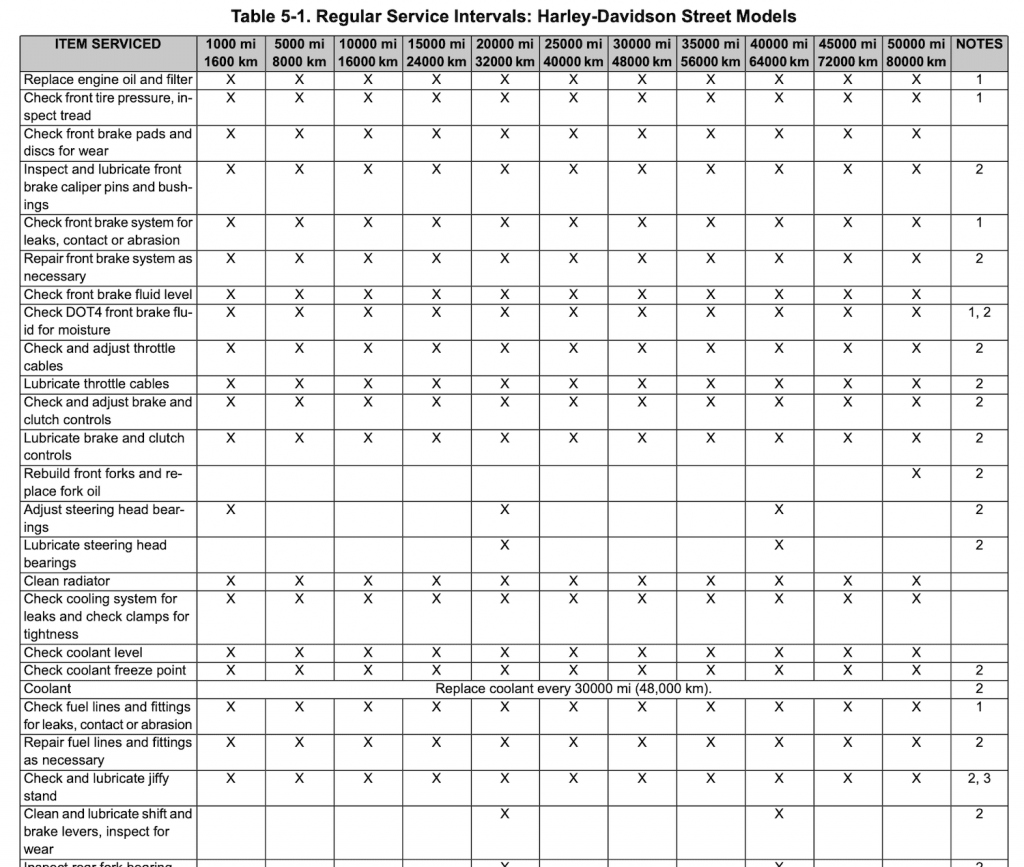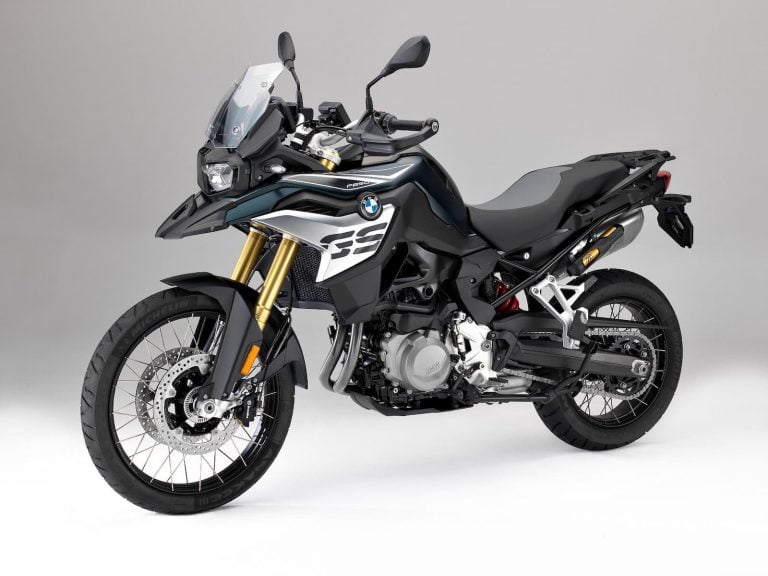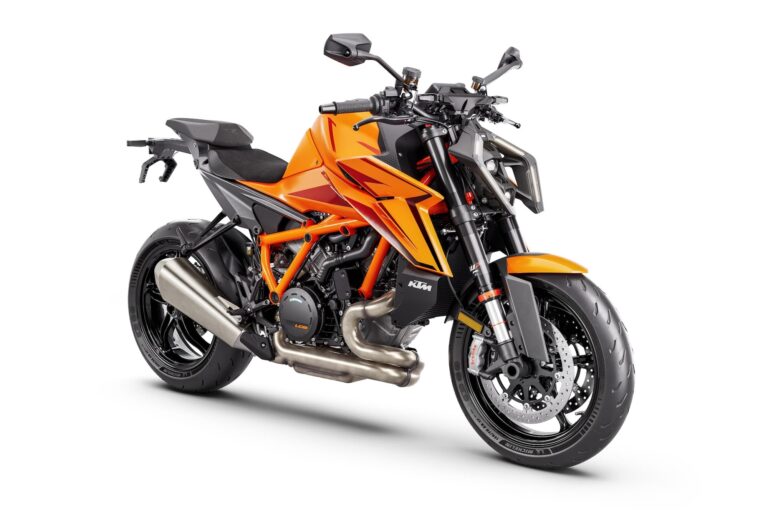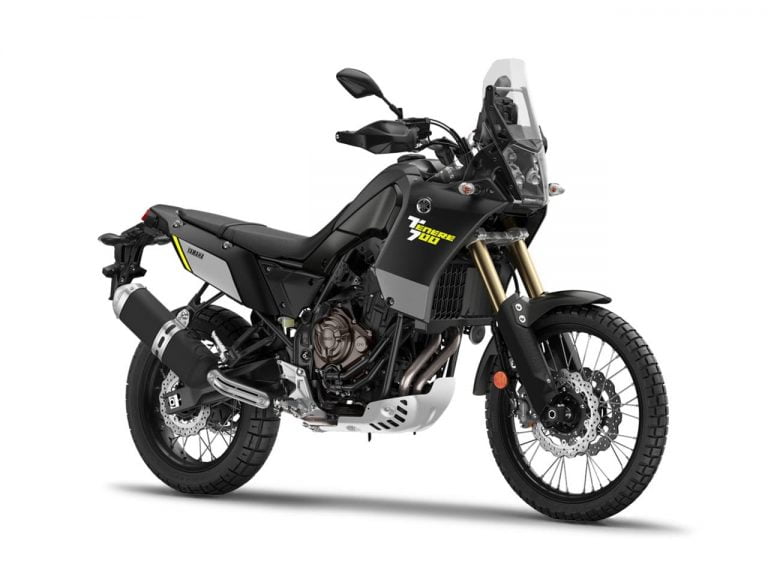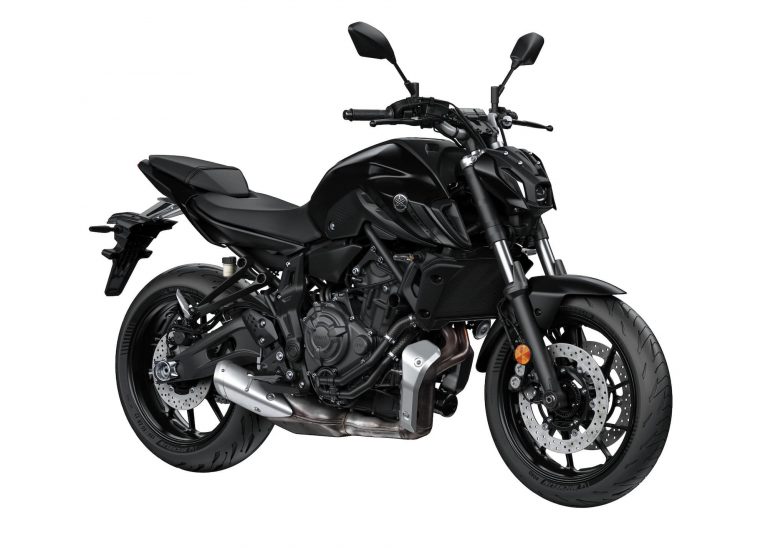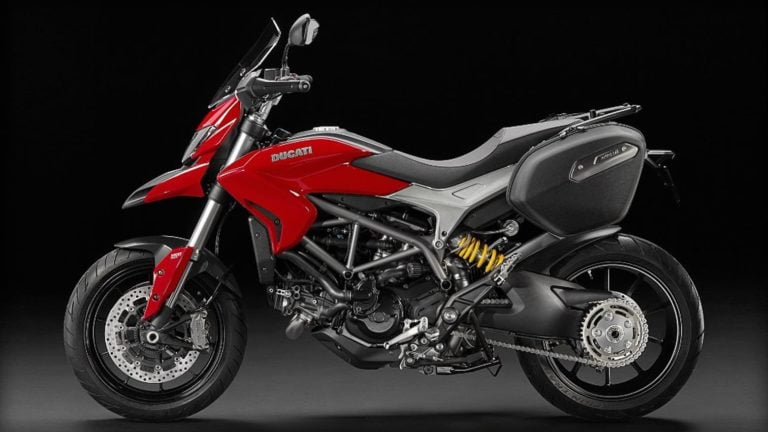Harley-Davidson Street Rod XG750A (2017-2020) Maintenance Schedule / Service Info
This is the maintenance schedule and service intervals for the Harley-Davidson Street Rod XG750A, one of Harley-Davidson’s mid-sized motorcycles in the “Street” platform that ran from 2015-2020.
The Harley-Davidson Street Rod is based on the High Output Revolution X engine, a liquid-cooled fuel-injected 749cc (46 c.i.) 60-degree V-twin. It has a single overhead cam and 4 valves per cylinder (8 valves total).
With a compression ratio of 12.0:1 (helped by liquid cooling), the Street Rod makes peak torque of 64 Nm (47 lb-ft) at 4000 rpm, and peak power of 68 hp (50 kW) at 8750 rpm, good sporty mid-range power. This is higher spec than the Street 750, an otherwise closely related engine.
You might also be looking for Harley-Davidson Street Rod based on the early V-Rod platform, the VRSCR.
Other motorcycles in the Street range include the Street 750 (XG750) and the Street 500 (XG500).
This site has links for things like oil and spark plugs from which we earn a commission (which unfortunately nobody can save, not even us). If you appreciate this work, then please use those links. Thanks!
Harley-Davidson Street Rod (XG750A) Service Intervals
Generally, the Harley-Davidson Street Rod (XG750A) has 5,000 mile / 8,000 km or annual service intervals. At each of these periods (whichever comes first), change the oil and filter, and do a host of other checks on the motorcycle.
The major service, the valve lash adjustment, is every 15,000 mi or 24,000 km (with no time component). While the Revolution X engine doesn’t have hydraulic valve lash adjusters, the valve check and adjustment procedure is at least simple, as the engines have a single overhead cam design with rocker arms, and the valve adjustment is via a screw-and-locknut type adjustment — i.e. you can do it with the camshafts in place. The only complication is that there are two cylinder heads, and so you need to get access to both.
Aside from that, maintain your fluids regularly, replacing your brake fluid and your coolant per the schedule.
The final drive is a belt, so that aspect of the Street Rod is low-maintenance. Just check it for wear and tension and adjust as needed.
Maintenance schedule for the Harley-Davidson Street Rod XG750A
Below is the service schedule for the Harley-Davidson Street Rod. This comes from the manual, but has been clarified for legibility.
For simplicity, the schedule is broken into two sections:
- The maintenance schedule of main items like oil changes, spark plugs, and valve service, and
- The “Annual Inspection” checklist
Major Items Maintenance Schedule
Below is the schedule of major items to be serviced on the Harley-Davidson XG750A.
Notes
- The break-in period has passed, so that part of the schedule is omitted.
- If an item (e.g. oil changes) has to be serviced at a certain distance or time, follow the earlier of the two.
- At the end of the schedule, keep repeating it in the pattern shown.
| mi x 1000 | 5 | 10 | 15 | 20 | 25 | 30 | |
|---|---|---|---|---|---|---|---|
| km x 1000 | 8 | 16 | 24 | 32 | 40 | 48 | Every |
| Annual service checklist (see below) — Perform all items | ✓ | ✓ | ✓ | ✓ | ✓ | ✓ | Year |
| Engine oil — Replace (Harley recommends H-D 360, or a 20W-50 engine oil with CH-4 or above classification, e.g. Mobil 1 20W-50) | ✓ | ✓ | ✓ | ✓ | ✓ | ✓ | Year |
| Oil filter — Replace (HF175) | ✓ | ✓ | ✓ | ✓ | ✓ | ✓ | Year |
| Air filter, — Inspect, and clean/replace if required (HD-7515, different from other Street models) | ✓ | ✓ | ✓ | ✓ | ✓ | ✓ | More often if riding in severe conditions |
| Valve clearances (valve lash) — Inspect, adjust as necessary | ✓ | ✓ | More frequently in severe conditions | ||||
| Spark plugs — Replace (NGK CR9E or CR9EIX for iridium plugs) | ✓ | 2 years | |||||
| Brake fluid (front and rear) — Replace (Castrol DOT 4) | 2 years | ||||||
| Coolant — Replace (Harley-Davidson Extended Life Coolant, or an equivalent OAT coolant, e.g. Zerex G30) | ✓ | 30,000 mi (48,000 km) | |||||
| Shift and brake pedals — Clean and lubricate (lithium soap-based grease), and inspect for wear | ✓ | ||||||
| Steering head bearings — Lubricate | ✓ | ||||||
| Rear fork bearing — Inspect | ✓ | ||||||
| Rear shock absorber bushings — Inspect for wear and cracks | ✓ | ||||||
| Front fork — Rebuild (disassemble, inspect, rebuild, replace fork oil) | 50,000 mi (80,000 km |
Annual Service Checklist
Below is the annual service checklist for the XG750A. Do these checks at every service, annual or at distance intervals.
Note — Items marked “Annual” need to be done annually as well as at distance intervals. The others don’t need to be done at an annual service if no mileage has been done.
| Harley-Davidson Street Rod (XG750A) Inspection checklist | Annual |
|---|---|
| Brake systems — Inspect for leaks, contact, or abrasion. Repair as necessary | ✓ |
| Brake fluid, front and rear — Check moisture content. Replace if over 3%. (u=Hse Castrol DOT 4) | ✓ |
| Fuel lines and fittings — Check for leaks, pinches in lines, or abrasion. Repair as necessary | ✓ |
| Front and rear tires — Check tire pressure, condition, and tread. Adjust or replace if necessary | ✓ |
| 12-volt battery — Check voltage, terminal torque, and connection cleanness. Lubricate terminals with contact lubricant | ✓ |
| Exhaust system, fasteners, and shields — Check for leaks, cracks, loose or missing fasteners/shields | ✓ |
| Fuel cap lock — Lubricate | ✓ |
| Drive belt and sprockets — Inspect condition and tension, adjust as necessary | |
| Brake pads and discs, front and rear — Inspect for wear, replace if necessary | |
| Brake caliper pins and bushings, front and rear — Inspect and lubricate | |
| Brake fluid, front and rear — Check level, top up as necessary (Castrol DOT 4) | |
| Brake and clutch controls — Check, adjust, and lubricate (Protect All Cable Life) | |
| Throttle cables — Check, adjust, and lubricate | |
| Cooling system — Check for leaks and clamps for tightness | |
| Coolant — Check level and freeze point. Replace as necessary (Zerex G30) | |
| Radiator — Clean | |
| Jiffy stand — Check and lubricate (Lithium soap based grease) | |
| Electrical equipment and switches — Check operation | |
| Road test — Verify components and system functions |
Checking and Adjusting Valve Clearances on the Street Rod (XG750A)
The Street Rod has mechanical valve lifters, so you need to check and adjust the valve clearances periodically. Luckily, the valve clearance check and adjustment can be done with the camshafts in situ.
(Note for fact-checkers — Bennetts incorrectly claims that the Street Rod has hydraulic valve lash adjusters, so I presume other sources may say the same.)
To adjust the valve clearances on your Harley-Davidson Street Rod, follow the procedure below.
- Remove the ground cable from the frame stud for safety.
- Loosen and move the fuel tank backwards to increase room, installing a brace to hold the tank in place.
- Pull the spark plug leads (but don’t remove the plugs yet)
- Remove the valve cover bolts (8mm wrench)
- Remove the air cleaner assembly (check the cleaner at the same time), and the breather assembly.
- Protect the top of the valve cover with a cloth, lift it, and remove it.
- Clean debris away from spark plug area and remove plugs.
- Jack up the motorcycle until the rear wheel is free
- Rotate the wheel forward with the motorcycle in gear. Find the TDC — arrow on the camshaft sprocket should be pointing up.
- Use feeler gauges to measure the clearances.
Below are the valve clearances for the XG750A from the service manual. While the cams have more lift and duration, the valve lash is identical to that of the XG750.
| Valves | mm | in |
|---|---|---|
| Intake valves | 0.15-0.20 | 0.006-0.008 |
| Exhaust valves | 0.20-0.25 | 0.008-0.010 |
If the valve clearances are out of spec (or at the loose end of the range), tighten them to the tightest end of the range. Use a 10mm tappet lash adjustment tool along with a clearance gauge. After setting the clearance, tighten the locknut, and re-check the thickness.
When replacing the cover, use a new gasket if necessary. Then re-install all the components in the reverse order.
The video below (starting at 19:07) is an excellent reference. The guidelines are applicable to the Street 500, Street 750, and Street Rod.
Street Rod (XG750A) Drive Belt Maintenance
The Harley-Davidson Street Rod (XG750A) has a belt final drive.
While it’s low maintenance, Harley-Davidson still recommends you regularly check the belt for wear or damage as part of the pre-ride checklist. They get old, rocks get caught in them, and they’re still exposed to the elements.
At every service, you also have to check drive belt condition and deflection. Check deflection using a standard belt tension tool.
Follow this procedure for checking belt tension on the Harley-Davidson Street 750.
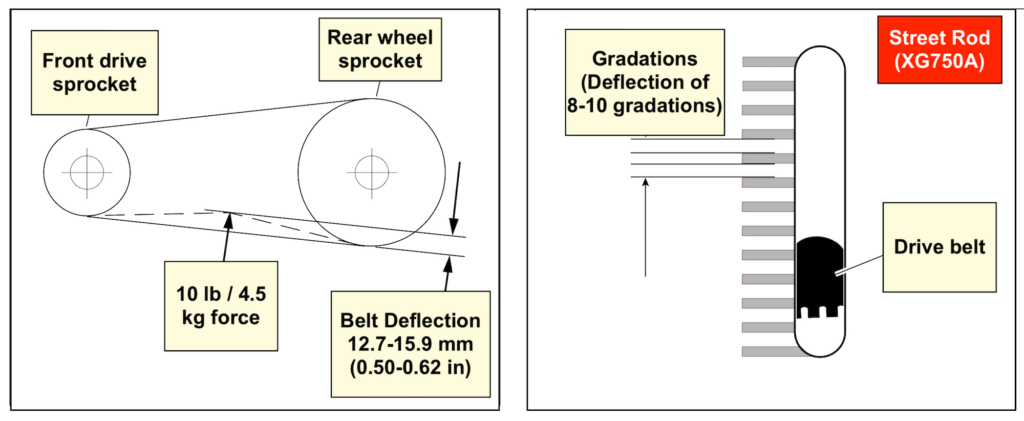
- Put the motorcycle on its side stand and in neutral.
- Find the belt deflection measurement window on the side of the motorcycle. Use a belt tension tool to push up on the drive belt in this area with a pressure of 10 lb / 4.5 kg.
- Measure the belt deflection. Each gradation is 1/16 in (1.6 mm).
Target belt deflection for the Street Rod: 12.6-15.9 mm (0.5-0.62 in) (8-10 gradations)
If the belt is out of spec, then you need to adjust it (usually tighten). Follow these steps:
- Elevate the rear wheel using a stand. (You take the tension measurements with the wheel on the ground, but adjust the tension with the wheel elevated, as you need to move the axle back.)
- Use a breaker bar with an appropriate wrench to loosen the rear axle. You may need a special wrench or to remove the exhaust.
- Use a small wrench to turn the belt tension adjusters on either side of the bike. Make small changes — a 1/4 turn can make a huge difference. You have to lower the motorcycle again to measure the deflection with the weight on the wheel again.
- Make sure you tighten the nuts the same amount on each side. Check the belt and make sure it’s in tension and aligned.
- Tighten the rear axle to 96-104 lb-ft or 130-141 Nm with a large torque wrench.
Tire sizes for the Harley-Davidson Street Rod XG750A
| Wheel | Tire size (USA, Europe, Australia, Rest of world) | Tire size (India) | Tire pressure (both tire types) |
|---|---|---|---|
| Front | Michelin Scorcher 21 120/70R17 M/C 58V | MRF REVZ-FH1 120/70R17 M/C 58H | 36 psi / 248 kPa |
| Rear | Michelin Scorcher 21 160/60R17 M/C 69V | MRF REVZ-H 160/60R17 M/C 69H | 42 psi / 290 kPa |
About the Harley-Davidson Street Rod (XG750A)
The Harley-Davidson XG750A Street Rod is a higher-output, more aggressive version of the XG750, which is just known as the Street 750. Harley-Davidson released the Street Rod for 2017, two years after the Street 750 and 500.
Note that the Street Rod shares a name with another, quite different motorcycle – the VRSCR Street Rod, based on the 1130 V-Rod platform.
The XG750A is still the same basic concept as the XG750 — an entry-level Harley-Davidson with a liquid-cooled engine. Like the Street 750, the XG750A is based on the Revolution X engine in 749cc format, a liquid-cooled 60-degree V-twin that has a single overhead cam and four valves per cylinder. Modern-ish but still classic technology.
But Harley-Davidson didn’t just warm over the Street 750. They gave it an inverted fork, twin disc brakes, and a higher-power engine, tuned with higher lift and duration cams, a higher compression ratio, different suspension and wheels, much more lean, higher revs, and more peak power. Aside from an engine with the same bore and stroke, it’s essentially a totally different bike.
Unlike the Street 750, the Street Rod isn’t just an entry-level bike — it’s designed to compete with other simple middleweight motorcycles, like the Suzuki SV650 for example, or the Triumph Bonneville T100.
Harley introduced the Street Rod to capture the imagination (and wallets) of buyers in Europe, who tend to opt for smaller, more agile motorcycles than your typical Harley-Davidson “Big Twin”. The problem is that it was in a tough crowd. It was competing against Harley’s own Iron 883, and aside from that, loads of other middleweight sport bikes. In many ways, though aside from brand power, the Street Rod was up against the Yamaha MT-07 — a formidable foe!
To go with the higher-performance engine, Harley-Davidson adjusted the wheels, suspension, and riding position of the Street Rod. Rather than in a relaxed everyday riding position, riders on the Street Rod are more hunched forward, with knees up in the air. Many riders actually find it uncomfortable, particularly as the taller footpegs seem to be at different heights.
The best part of the Street Rod is that, like the Street 750, maintenance is easy and performable by the home mechanic. The Street Rod has mechanical valve lifters, but adjusting them is a doddle thanks to screw and locknut-type adjusters that don’t require you to take off the camshafts. Plus, that service is only every 16,000 miles / 25,000 km. Finally, the belt is also low maintenance.
Harley-Davidson discontinued the XG750A in 2020, but in 2021, Harley-Davidson announced the Sportster S, another liquid-cooled sporty motorcycle, with considerably higher specifications.
Reference — Manual for the Harley-Davidson Street Rod
The above maintenance schedule came from the manual for the Harley-Davidson Street Rod (XG750A).
However, the schedule was re-ordered and written to be more comprehensible, putting things that should be together with each other.
You can find the manual for the Street Rod online here.
